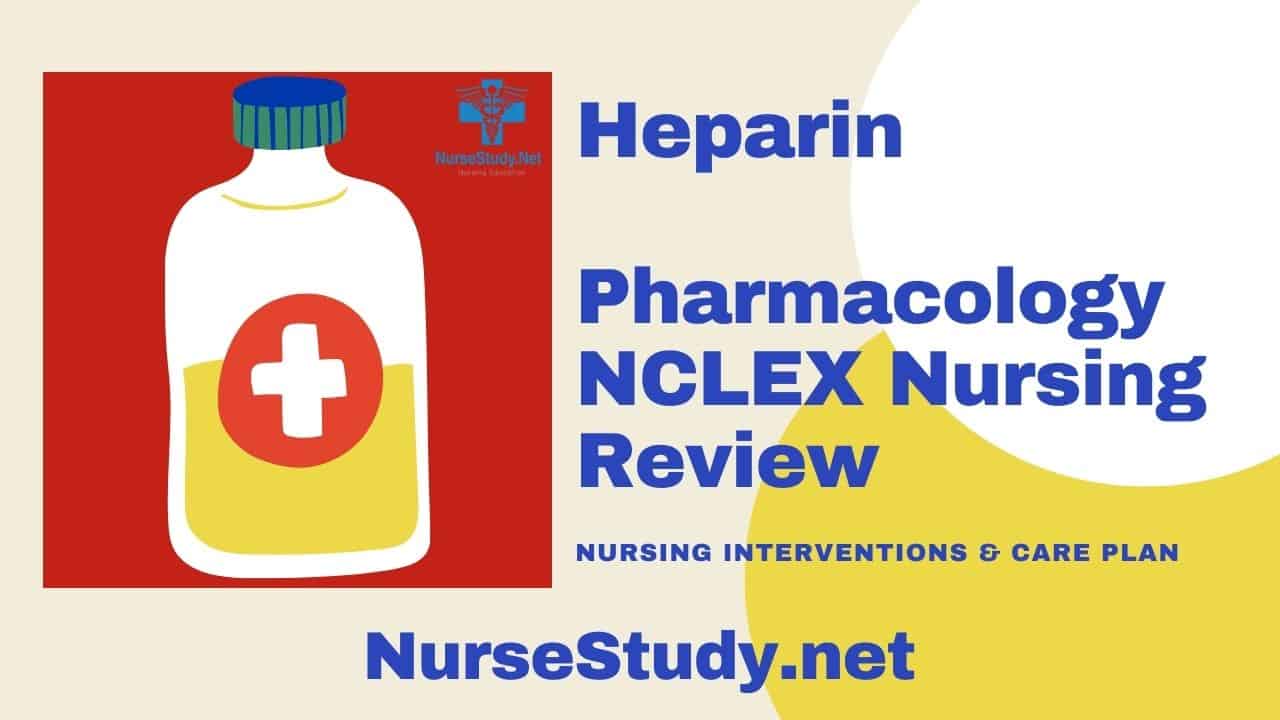Heparin is an anticoagulant medication used to prevent and treat blood clots. To ensure safe and effective use, nurses must understand its proper administration, potential side effects, and important patient teachings.
Generic name: Heparin
Brand names: Heparin Sodium, Hep-Lock, Hep-Lock U/P, Heparin Lock Flush Solution, Heparin Sodium Injection
Pharmacologic class: Anticoagulant
Therapeutic class: Anticoagulant, antithrombotic
Mechanism of action: Heparin enhances the activity of antithrombin III, which inhibits several clotting factors, primarily thrombin and factor Xa. This action prevents the formation of new clots and the extension of existing ones.
Indications for use: Prevention and treatment of venous thromboembolism (deep vein thrombosis and pulmonary embolism), acute coronary syndrome, atrial fibrillation, and certain medical procedures such as cardiopulmonary bypass and hemodialysis.
Precautions and contraindications: Hypersensitivity to heparin or pork products, active major bleeding, severe thrombocytopenia, and history of heparin-induced thrombocytopenia (HIT). Use caution in patients with recent surgery, ulcers, or other conditions that increase bleeding risk.
Drug Interactions
- Antiplatelet agents (e.g., aspirin, clopidogrel) and other anticoagulants increase bleeding risk.
- Nonsteroidal anti-inflammatory drugs (NSAIDs) may increase bleeding risk
- Nitrates may decrease heparin’s effectiveness
- Digoxin, nicotine, and tetracyclines may decrease heparin’s effect
Adverse Effects
- Bleeding (major and minor)
- Heparin-induced thrombocytopenia (HIT)
- Osteoporosis (with long-term use)
- Hyperkalemia
- Elevated liver enzymes
- Skin necrosis at injection sites
- Allergic reactions (rare)
Administration Considerations
Available preparations: Intravenous (IV) solution, subcutaneous (SC) injection
Dosages: Vary widely based on indication, patient factors, and monitoring parameters. Always follow specific prescriber orders and institutional protocols.
- For DVT prophylaxis: typically 5,000 units SC every 8-12 hours
- For DVT treatment often starts with a bolus of 80 units/kg IV, followed by continuous infusion
Route:
- IV (continuous infusion or intermittent)
- SC
Onset: Immediate (IV), 20-60 minutes (SC)
Duration: 2-6 hours
Nursing Considerations for Heparin
Related Nursing Diagnoses
- Risk for bleeding related to anticoagulant therapy
- Risk for ineffective tissue perfusion related to potential thrombus formation
- Anxiety related to anticoagulant therapy and potential complications
- Deficient knowledge related to heparin therapy and self-care requirements
Nursing Assessment
- Assess for any history of bleeding disorders, recent surgeries, or conditions that increase bleeding risk.
- Evaluate for signs of active bleeding before and during heparin therapy.
- Monitor platelet count closely, especially during the first two weeks of therapy, to detect heparin-induced thrombocytopenia (HIT).
- Assess aPTT (activated partial thromboplastin time) or anti-Factor Xa levels as ordered to ensure therapeutic anticoagulation.
- Monitor for signs of thrombosis, particularly in patients with a history of HIT.
Nursing Interventions
- Administer heparin as prescribed, ensuring the correct dose, route, and rate of administration.
- When administering subcutaneous heparin, rotate injection sites to prevent tissue damage and ensure proper absorption.
- Use an infusion pump to ensure an accurate delivery rate for IV administration.
- Implement bleeding precautions: use soft toothbrushes and electric razors, and avoid IM injections.
- Monitor all invasive sites, wounds, and body orifices for signs of bleeding.
- Be prepared to administer the antidote protamine sulfate in case of severe bleeding or heparin overdose.
- Educate patients and families about the importance of adherence, potential side effects, and when to seek medical attention.
Patient Teaching Associated with Heparin
- Explain the purpose of heparin therapy and the importance of following the prescribed regimen.
- Teach patients to recognize signs of bleeding (unusual bruising, nosebleeds, blood in urine or stool) and report them immediately.
- Instruct patients to avoid activities with a high risk of injury or bleeding.
- For patients on subcutaneous heparin at home, demonstrate proper injection technique and site rotation.
- Advise patients to inform all healthcare providers about their heparin therapy before any medical or dental procedures.
- Encourage patients to wear medical alert identification indicating anticoagulant use.
- Stress the importance of regular blood tests to monitor therapy effectiveness and safety.
- Counsel patients on the need for dietary consistency, especially regarding vitamin K intake, which can affect anticoagulation.
This is not an all-inclusive list of possible drug interactions, adverse effects, precautions, nursing considerations, or patient instructions. For complete information, please consult with a pharmacist or refer to current drug information resources.
References and Sources
- Garcia, D. A., & Crowther, M. A. (2019). Parenteral anticoagulants: Heparin, low molecular weight heparin, and fondaparinux. In J. S. Tirnauer (Ed.)
- Smythe, M. A., Priziola, J., Dobesh, P. P., Wirth, D., Cuker, A., & Wittkowsky, A. K. (2016). Guidance for the practical management of the heparin anticoagulants in the treatment of venous thromboembolism. Journal of Thrombosis and Thrombolysis, 41(1), 165-186.
- Kearon, C., Akl, E. A., Ornelas, J., Blaivas, A., Jimenez, D., Bounameaux, H., … & Moores, L. (2016). Antithrombotic therapy for VTE disease: CHEST guideline and expert panel report. Chest, 149(2), 315-352.
- Gray, E., Mulloy, B., & Barrowcliffe, T. W. (2008). Heparin and low-molecular-weight heparin. Thrombosis and Haemostasis, 99(05), 807-818.
